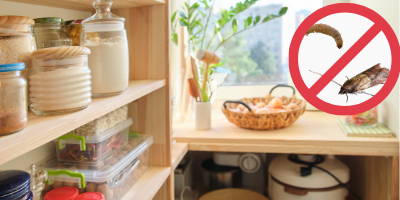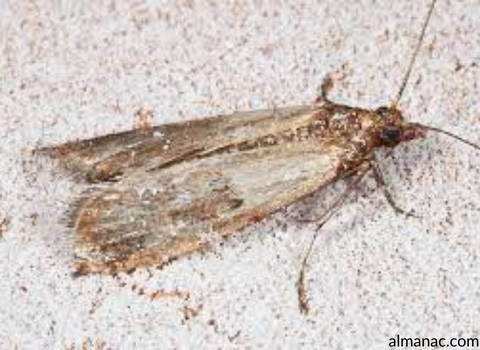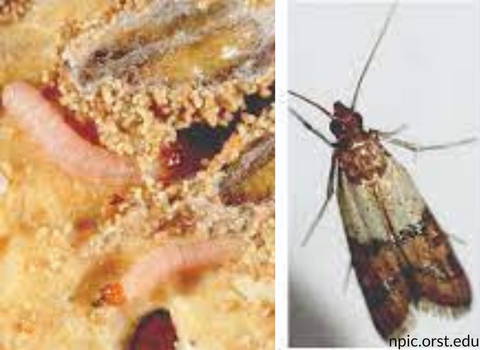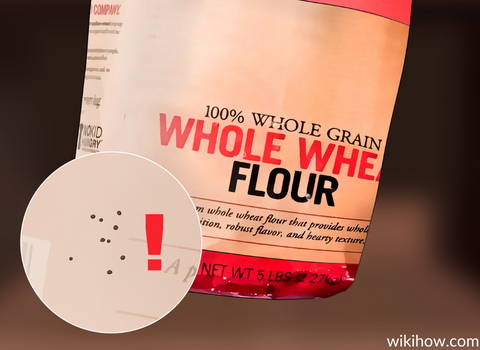Where Do Pantry Moths Come From
Ever noticed weird clumps in an old bag of flour or the new one you got from the store? Or maybe the webbing along the edges or corners of rice or food packaging that seems to be moving? If no, then you are lucky enough to prevent an unsettling problem. However, if yes, you are most likely dealing with pantry moths.
Pantry moths can enter your home in different ways. They do not appear suddenly on any of the items in your pantry. These pantry moths get in your house in one way or another.
Among the common ways is by going in through your windows and doors. They can also enter your home through openings around plumbing lines, dryer vents, or cables passing through the walls.
Another way they can enter your house is by stowing away inside any of the food packaging or contaminated food from a warehouse or store such as pet food. Once they get into any food item and your pantry, it is most likely that the problem will get bigger.
What are Pantry Moths?
Pantry moths are referred to as Indian Meal Moth or commonly referred to as Flour Moths. The term Indian Meal Moths was created by an entomologist in the 1800s. The entomologist was observing the larvae infesting cornmeal which was called Indian Meal. The other names were created because of the common locations where these pests are found inside a house.
These pantry moths are considered the most common pantry pest in the United States. Unlike other types of pests, what makes it different is that these are attracted to stored foods, most especially dry foods.
Homeowners usually notice infested food because of clumping within the flour, webbing on the packaging, or the sight of moving moth larvae in the dry food items. However, not all larvae are noticeable, which is why you only get to confirm an infestation when you see these pests in their adult stage and are flying around.
The main objective of pantry months is to reproduce. This means that if they complete their life cycle inside your home and there is an abundant food supply, they will survive.
Your home will give them the safe place they need to lay their eggs and give their offspring a high chance of surviving. They mainly rely on their sense of smell for them to look for a food source and to find a mate. Since you might not notice their presence until you see an adult moth flying around your home, there is a great chance that they have laid their eggs in other parts of your home.
Do Pantry Moths Bring Health Risk?
Though considered pests, pantry moths are not known to spread any disease. However, they can contaminate food when they travel from the kitchen to the pantry.
The presence of these pests is not only unsettling to see but may also cause expensive replacement. Say, for example, in food processing facilities. Whenever there is a pantry moth infestation, their webbing may result in major damage to machinery. Thus, requiring expensive replacement for the damages and delays in production caused by the infestation.
How to Identify a Meal Moth Infestation
There are a few things that you should keep in mind when trying to identify a meal moth infestation. When identifying an infestation, try to look for the following:
Larvae in Food Items
The first sign of an infestation is when the eggs hatch and you see larvae in food items such as flour, cereal, and other dry goods. These larvae are about 2/3” in length with brown or black heads. You may also notice tiny cast-off skins that are left when the worms move away.
Larvae in Any Part of Your Home
If there is an infestation, you will most likely find larvae hanging from walls, moving about the walls, or near the ceiling. They are always in the search for dark crevices to pupate until they turn into adult moths.
Cocoons
Aside from the presence of larvae, you may also find webby cocoons in corners or on top of cabinets.
Flying Adult Moths
Moths that are about half-inch long and reddish brown only mean that your house is infested by these pests. These flying moths will be flying around the kitchen or pantry around lights especially at night.
Once you confirm the presence of these pests, you must act immediately by starting pest control methods.
How to Get Rid of Pantry Moths
To stop these pests from reproducing and stop infesting your home, below are ways you can do to get rid of pantry moths.
Eliminate the Source
Seek for the package that brought the larvae into your home. Once you find it, wrap it securely in a plastic back and discard it immediately.
Clean Your Pantry Thoroughly
One of the first things that you should do is throwing away all grains and food packages that cannot get wet such as bags and boxes. Pantry moths usually lay eggs in crevices and these include folds of packages. If there is a severe infestation, you should throw everything away. Do not forget to throw away all shelf liners.
Wash all unopened cans and jars under hot, soapy water and use a toothpick to scrape the cracks around the lids of the jars to check for eggs. You should also wash the inside of the cabinet or pantry with water and soap and then followed by a weak bleach solution. Rinse it with peppermint oil, water, and vinegar mixture to repel moths and kill eggs.
If your pegboard or shelves are adjustable, use a toothpick to clean the peg holes as these are common hiding grounds for webs and eggs.
When using a vacuum cleaner, make sure to immediately change the vacuum bag and clean the vacuum. Lastly, take out all recyclables and trash. Make sure to clean the recycle bins and trash cans thoroughly.

Use Pheromone Traps
The sticky traps will attract male moths. This may not eliminate all the moths, but it can help you in monitoring the ongoing infestation.
Treat Suspected Food
If you are suspecting food products that are infested by pantry moths, you can bake them in the oven at 140 °F or higher for an hour or in the microwave for 5 minutes in a high setting. You can also put them in a plastic bag and put them in the freezer for about a week.
As much as possible, avoid sprays since pesticides are not supposed to be used anywhere near food products.
Reminder:Itmay take up to six months or so to get rid of all pantry moths as well as hatching larvae inside your home. Try to hold off restocking the pantry until you are sure that the pantry moths are completely gone.
How to Prevent a Pantry Moth Infestation
There are a couple of things that you can do to prevent pantry moths from infesting your home. Try doing the following:
Place all dry foods in airtight containers before putting them in your pantry.
Do a routine check of all items inside the pantry including newly bought and sealed items.
Preventing an infestation is easier than dealing with all the cleaning that you have to do with your pantry. In case your home is already infested, be proactive and act immediately to get rid of pantry moths quickly.





